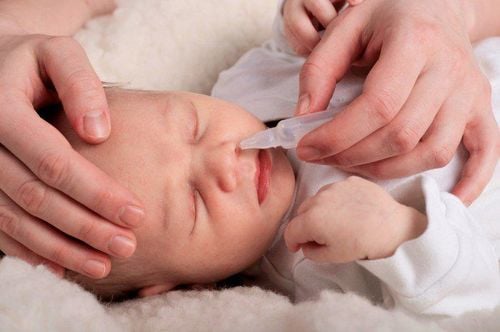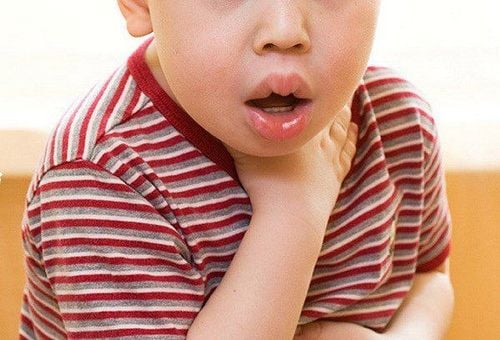This is an automatically translated article.
The article was consulted with Specialist Doctor I Nguyen Thi My Linh - Neonatologist - Department of Pediatrics - Neonatology - Vinmec Danang International General Hospital.A stuffy nose and difficulty breathing is a common condition in young children, especially infants. Although a child's stuffy nose is usually harmless, it can sometimes be uncomfortable for a child, causing them to breathe quickly or to wheeze or sneeze. Symptoms vary depending on the location and extent of the blockage. However, parents can help relieve their baby's stuffy nose by applying home remedies that quickly help ease their baby's discomfort.
1. Causes of a stuffy nose
Young children, especially infants, are more prone to nasal congestion than older children and adults because their nasal passages and lower airways are small and tender, and the cartilage in the airways is immature. Premature babies may face a higher risk of nasal congestion than full-term babies.Tobacco smoke, viruses and exposure to dry air are some of the possible causes of a stuffy nose in babies. Indeed, when children inhale these agents, the lining of the airways is irritated, producing extra mucus in the nose and airways to clear these irritating airway allergens. From there, the excess amount of mucus produced will cause a blockage.
In addition, the causes that can lead to children having a stuffy nose and having trouble breathing include:
Change in weather. Viral infections, such as a cold. Breathe in air pollutants. Crooked walls . Allergy.

2. What are the symptoms of a stuffy nose and difficulty breathing?
Symptoms of nasal congestion in children can vary depending on the location and extent of the blockage. Because the child is young, the size of the airway is not stable, the cartilage on the airway is still soft, easy to be flattened or blocked, sometimes it is difficult to distinguish where the obstruction is.Usually, when a child has a stuffy nose, parents and caregivers can tell by noticing the following symptoms:
The baby's breathing becomes louder or more noticeable. Snoring while sleeping. Mild difficulty in feeding and sucking milk. Nose is stuffy. Dry cough or cough with phlegm. Have a runny nose. Sniffled. In the case of a child with an underlying airway obstruction, symptoms may include:
Rapid, rapid breathing. Dry cough, continuous cough. Children don't eat, suck poorly. Crying continuously. The skin turns purple when the baby cries or sucks.
3. 5 ways to treat baby stuffy nose
Compared to a stuffy nose, a runny nose can be a better thing for a child as it is the body's natural way of getting rid of germs. However, when the baby has too much mucus in the nose, it can cause a stuffy nose. The condition can also make it difficult for your baby to eat or breathe. At this point, a few home treatments can help your child improve his stuffy nose and get back to comfort quickly.Use drops with physiological saline Physiological saline is available in most stores. Put a few drops in each nostril of the child, then use a rubber straw to suck out the mucus in the nose, clearing the congestion for the child. The correct way to use the bulb is to squeeze the suction bulb first, gently place the tip in the baby's nostril, and release the bulb slowly; Wash with soap and water, let dry after each use.
Parents can repeat this as often as necessary during the day; Even, if done right before the baby eats, it will make mealtime easier.
However, this method works best for babies until they are less than 6 months old. For older children, they may cry more when using a suction bulb. If that happens, parents can simply use saline drops to thin the mucus, which they can then clear out of the nose on their own.
Get rid of nasal rust Sometimes mucus hardens into a hard or sticky lump around your baby's nose, called nasopharynx, which blocks the airways that are inhaled.
To safely clean your child's nose, every time you clean your child's nose every day, wet a cotton swab with warm water and gently wipe the inside of the child's nostrils, removing the adhesion on the nasal wall to avoid congestion.
Humidify the air Place a cooling mist or humidifier in your baby's room to add moisture to the air, especially when using an air conditioner.
Air humidity helps the physiological mucus layer on the surface of the airway mucosa not to dry out, helping to clear the baby's nose. However, parents need to clean the device regularly to prevent dirt and mold from growing inside the device.
An alternative that can still get the same soothing effect on the airways with a humidifier is to sit the child in a steam bath.
Paddle your baby's back Gently patting your baby's back can help relieve chest tightness caused by congestion. Parents can lay the baby on their knees and gently pat the baby's back with the cupped dominant hand.
Another way to pat your baby on the back with an older child is to have her sit on her lap with her body facing forward about 30 degrees. This position will loosen the mucus in the chest and make it easier for the child to cough up.
Monitoring Because children with stuffy nose and difficulty breathing are quite common and not all stuffy and runny noses need treatment. If the condition does not affect the child, parents or caregivers can monitor without doing anything as long as the baby is active and eating normally.
At the same time, parents also need to avoid giving children under 4 years old over-the-counter cough and cold medicines. If your child is between 4 and 6 years old, it's best to talk to your doctor about which medications are allowed.

4. When to take your child to see a pediatrician?
If home remedies don't work for the child, the parent or caregiver should take the child to the doctor.Furthermore, an earlier pediatrician should be considered if the child has any of the following signs:
Symptoms of a cold do not go away within three weeks. Breathe fast. High fever or persistent fever unresponsive to antipyretics. Hemoptisi. Children's stuffy nose is getting worse. Wheezing and pale skin In summary, mild to moderate shortness of breath is common in infants and lasts only a few days. With the above home interventions, parents can respond to stuffy noses in their children. What should be done to help the child quickly improve the situation, the child can breathe, eat and sleep as usual. However, if you are worried about your baby's ability to breathe or for an infant under 3 months of age, the above measures are not effective, the child should be taken to the doctor as soon as possible to be diagnosed. and intervene promptly and properly.
In addition, in order to prevent diseases that young children often get, parents should pay attention to nutrition to improve children's resistance. At the same time, add supporting foods containing lysine, essential micro-minerals and vitamins such as zinc, chromium, selenium, B vitamins,... snacks and less digestive problems.
Parents can learn more:
Why do you need to supplement Lysine for your baby?
The role of zinc - Guidelines for reasonable zinc supplementation
Please visit the website Vinmec.com regularly and update useful information to take care of your baby and family.
Please dial HOTLINE for more information or register for an appointment HERE. Download MyVinmec app to make appointments faster and to manage your bookings easily.
Reference articles: medicalnewstoday.com, webmd.com, firstcry.com













